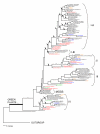Phylogenetic diversification of glycogen synthase kinase 3/SHAGGY-like kinase genes in plants
- PMID: 16504046
- PMCID: PMC1524769
- DOI: 10.1186/1471-2229-6-3
Phylogenetic diversification of glycogen synthase kinase 3/SHAGGY-like kinase genes in plants
Abstract
Background: The glycogen synthase kinase 3 (GSK3)/SHAGGY-like kinases (GSKs) are non-receptor serine/threonine protein kinases that are involved in a variety of biological processes. In contrast to the two members of the GSK3 family in mammals, plants appear to have a much larger set of divergent GSK genes. Plant GSKs are encoded by a multigene family; analysis of the Arabidopsis genome revealed the existence of 10 GSK genes that fall into four major groups. Here we characterized the structure of Arabidopsis and rice GSK genes and conducted the first broad phylogenetic analysis of the plant GSK gene family, covering a taxonomically diverse array of algal and land plant sequences.
Results: We found that the structure of GSK genes is generally conserved in Arabidopsis and rice, although we documented examples of exon expansion and intron loss. Our phylogenetic analyses of 139 sequences revealed four major clades of GSK genes that correspond to the four subgroups initially recognized in Arabidopsis. ESTs from basal angiosperms were represented in all four major clades; GSK homologs from the basal angiosperm Persea americana (avocado) appeared in all four clades. Gymnosperm sequences occurred in clades I, III, and IV, and a sequence of the red alga Porphyra was sister to all green plant sequences.
Conclusion: Our results indicate that (1) the plant-specific GSK gene lineage was established early in the history of green plants, (2) plant GSKs began to diversify prior to the origin of extant seed plants, (3) three of the four major clades of GSKs present in Arabidopsis and rice were established early in the evolutionary history of extant seed plants, and (4) diversification into four major clades (as initially reported in Arabidopsis) occurred either just prior to the origin of the angiosperms or very early in angiosperm history.
Figures







Similar articles
-
Phylogeny and evolutionary history of glycogen synthase kinase 3/SHAGGY-like kinase genes in land plants.BMC Evol Biol. 2013 Jul 8;13:143. doi: 10.1186/1471-2148-13-143. BMC Evol Biol. 2013. PMID: 23834366 Free PMC article.
-
Identification and characterization of two wheat Glycogen Synthase Kinase 3/ SHAGGY-like kinases.BMC Plant Biol. 2013 Apr 18;13:64. doi: 10.1186/1471-2229-13-64. BMC Plant Biol. 2013. PMID: 23594413 Free PMC article.
-
Organization and expression of the GSK3/shaggy kinase gene family in the moss Physcomitrella patens suggest early gene multiplication in land plants and an ancestral response to osmotic stress.J Mol Evol. 2005 Jul;61(1):99-113. doi: 10.1007/s00239-004-0302-6. Epub 2005 Jun 29. J Mol Evol. 2005. PMID: 16007489
-
Glycogen synthase kinase 3/SHAGGY-like kinases in plants: an emerging family with novel functions.Trends Plant Sci. 2002 Oct;7(10):457-61. doi: 10.1016/s1360-1385(02)02331-2. Trends Plant Sci. 2002. PMID: 12399181 Review.
-
Function and evolution of 'green' GSK3/Shaggy-like kinases.Trends Plant Sci. 2012 Jan;17(1):39-46. doi: 10.1016/j.tplants.2011.10.002. Epub 2011 Nov 1. Trends Plant Sci. 2012. PMID: 22051150 Review.
Cited by
-
Annotation and profiling of barley GLYCOGEN SYNTHASE3/Shaggy-like genes indicated shift in organ-preferential expression.PLoS One. 2018 Jun 19;13(6):e0199364. doi: 10.1371/journal.pone.0199364. eCollection 2018. PLoS One. 2018. PMID: 29920545 Free PMC article.
-
The Arabidopsis thaliana GSK3/Shaggy like kinase AtSK3-2 modulates floral cell expansion.Plant Mol Biol. 2007 May;64(1-2):113-24. doi: 10.1007/s11103-007-9138-y. Epub 2007 Feb 15. Plant Mol Biol. 2007. PMID: 17427040
-
The Amborella genome: an evolutionary reference for plant biology.Genome Biol. 2008;9(3):402. doi: 10.1186/gb-2008-9-3-402. Epub 2008 Mar 10. Genome Biol. 2008. PMID: 18341710 Free PMC article.
-
Two homolog wheat Glycogen Synthase Kinase 3/SHAGGY--like kinases are involved in brassinosteroid signaling.BMC Plant Biol. 2015 Oct 13;15:247. doi: 10.1186/s12870-015-0617-z. BMC Plant Biol. 2015. PMID: 26458871 Free PMC article.
-
CaSK23, a Putative GSK3/SHAGGY-Like Kinase of Capsicum annuum, Acts as a Negative Regulator of Pepper's Response to Ralstonia solanacearum Attack.Int J Mol Sci. 2018 Sep 11;19(9):2698. doi: 10.3390/ijms19092698. Int J Mol Sci. 2018. PMID: 30208566 Free PMC article.
References
-
- Emily-Fenouil F, Ghiglione C, Lhomond G, Lepage T, Gache C. GSK3beta/shaggy mediates patterning along the animal-vegetal axes of the sea urchin embryo. Development. 1998;125:2489–2498. - PubMed
Publication types
MeSH terms
Substances
LinkOut - more resources
Full Text Sources

